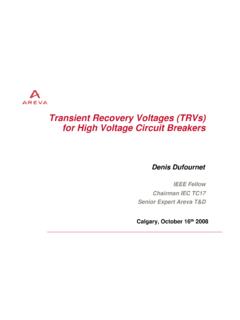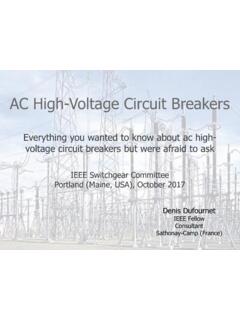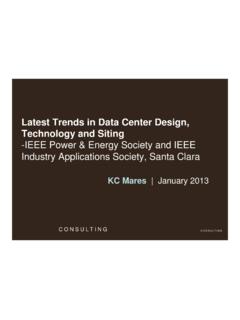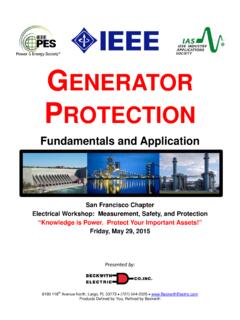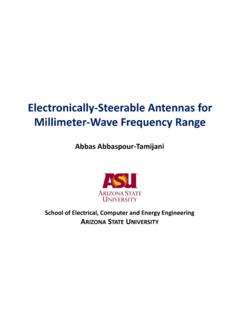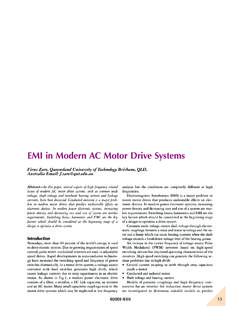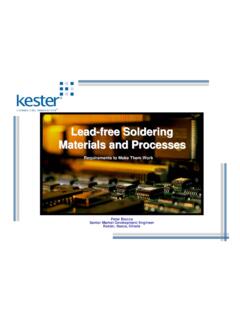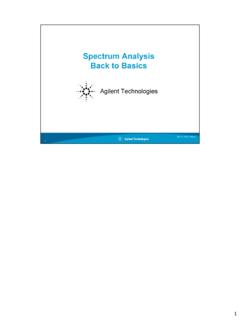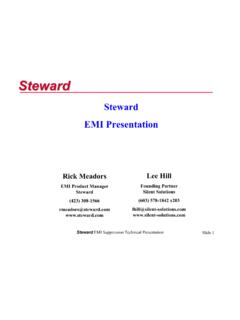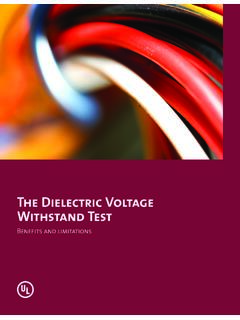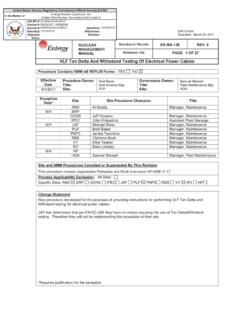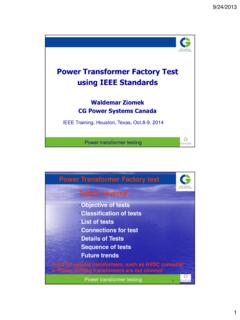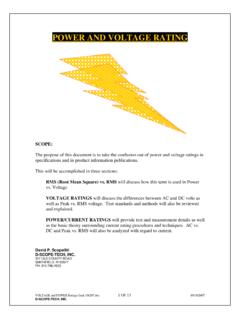Transcription of IEEE Standard 4
1 ieee Standard 4 Jeffrey A. BrittonChief Engineer, Phenix Technologies , ieee High voltage Testing Techniques SubcommitteeFall 2016 ieee Switchgear Committee MeetingOctober 9 13, Pittsburgh, PA1 ieee Standard for High- voltage Testing TechniquesScope of ieee Standard 4 dielectric tests with direct voltages dielectric tests with alternating voltages dielectric tests with impulse voltages tests with impulse currents tests with combinations of the above Capacitance and dielectric loss measurements Applies only to apparatus with rated voltage > 1 kV Procedures given for applying atmospheric correction factors Procedures given for testing external insulation subjected to wet, dry or contaminated conditions2 History of ieee Standard 4 Roots go back to the earliest Standardization Report of the American Institute of Electrical Engineers (AIEE) in 1889 First version of Standard 4 as a separate HV test and measurement Standard was published by AIEE in 1928 Present 2013 version is the eighth edition as a separate Standard The two most recent preceding versions were published in 1995 and 1978 respectively An amendment ( ieee Std 4a) was published in 2001, re-introducing the 1978 atmospheric correction factors (request of ieee Switchgear Committee)3 Position Within the ieee Maintained by the High voltage Testing Techniques (HVTT) Subcommittee of the Power Systems Instrumentation and Measurement (PSIM) Committee Referenced by all ieee power apparatus committees PSIM Officers: Jim McBride, JMX Services -Chair Ernst Hanique, DNVGL KEMA Laboratories, -Vice Chair Jeffrey Britton, Phenix Technologies -Secretary Farnoosh Rahmatian, NuGrid Power Corp.
2 -Awards Committee Eddy So, NRC Canada - standards Coordinator HVTT Officers: Jeffrey Britton, Phenix Technologies -Chair Jim McBride, JMX Services -Vice Chair Yixin Zhang, HVATOZ Consulting -Secretary4 Present Status of the Document ieee Standard 4-2013 was published on May 4th, 2013 Present version is comprised of: 199 pages 15 Clauses in the Main Body 1 Normative and 4 Informative Annexes 20 Tables 54 Figures 119 Numbered Equations 244 Bibliographical References Remains valid through 12/31/20235 Relationship to IEC standards IEC 60060-1 High- voltage test techniques Part 1: General definitions and test requirements IEC 60060-2 High- voltage test techniques Part 2: Measuring systems IEC60052 Recommendations for voltage measurement by means of Standard air gaps6 ieee Std. 4 Includes Information Also Covered in the Following IEC to IEC IEC 60507 Artificial pollution tests on high- voltage insulators to be used on systems IEC 61245 Artificial pollution tests on high- voltage insulators to be used on systems IEC 62475 High-current test techniques definitions and requirements for test currents and measuring systems7 Relationship to IEC ieee directive is to produce standards that are in technical alignment with the equivalent IEC standards , to the degree possible Standard 4 and the associated IEC standards are generally technically equivalent A major goal of Standard 4 is to include more tutorial information.
3 With the aim of educating test engineers in proper high- voltage testing technique8In in New Revision The new document represents a major revision over the 1995 version Significant reorganization of the material Major shift from the concept of determining the measurement error to estimating the measurement uncertainty using internationally accepted methodology (ISO/IEC Guide 98-3) More emphasis is placed on creating and maintaining a Record of Performance for measuring systems to track and document accuracy and stability over time9 Changes in New Use of a sphere gap as a calibration device for alternating and impulse peak voltage magnitude has been removed, however a sphere gap used in accordance with the Standard is still considered an approved measuring device The sphere gap is no longer considered valid for use when measuring direct voltages, with rod-rod gaps being specified More information is given on methods for determining linearity of measuring systems when a full voltage reference measuring system is unavailable10 Changes in New The 1978 methodology for atmospheric correction of test results has been replaced into the main Standard as an alternative method, for equipment manufacturers needing to perform routine tests on older equipment designs.
4 Which were originally designed and tested in accordance with the 1978 atmospheric correction procedures The most significant technical change is in the methodology used to determine impulse parameters for lightning impulses having oscillations near the peak ( k-factor , or test voltage Factor method)11 Reorganization of Material In the 1995 edition of Standard 4, material on testing techniques, measuring system requirements and potential sources of error in measurements was spread across different clauses throughout the Standard In the 2013 edition, all material that is germane to a given waveform ( AC, DC, Impulse voltage , Impulse Current) is covered in separate, respective clauses Result is a Standard that is much more user-friendly to engineers and test technicians who must interpret and apply the Standard requirements12 Uncertainty versus Error The uncertainty of a measurement result gives the boundary limits within which the true value of the measurand, within a given level of confidence, is expected to lie The methodology includes errors in repeatability (random fluctuation) for a series of measurements (Type A uncertainty) as well as other known sources of uncertainty (manufacturer s specifications, resolution, thermal stability, environmental effects, etc.)
5 Arising from the measuring equipment (Type B uncertainty) Type A and Type B components are combined in a root sum square calculation, then multiplied by a coverage factor to obtain the desired confidence level Note that measuring uncertainty is distinct from test voltage tolerance13 Record of Performance for a Measuring System14 DesignMeasuringSystemManufactureMeasurin gSystemPerformTypeTestsDocumentType TestResultsInstallMeasuringSystemPerform AcceptanceTestsGenerate Record ofPerformanceUseMeasuringSystemPeriodicP erformanceCheck Due?YesDoPerformanceCheckProblemEncounte red?UpdateRecord ofPerformancePeriodicPerformanceTest Due?NoYesDoPerformanceTestYesNoNoMeasuri ng SystemManufacturerMeasuring SystemManufacturerand / or UserMeasuringSystemUserRecord of Performance for a Measuring TestsVerification of Operating Temperature RangeFrequency ResponseVerification of Duty CycleProximity EffectsAcceptance Tests15 Acceptance TestsDetermination of Measuring System Short Term StabilityWithstand voltage TestPerformance TestsPerformance TestsDetermine or Verify Measuring System Scale FactorDetermine or Verify Measuring System LinearityExample of Required Contents of Record of Performance for anAC High- voltage Measuring SystemUse of test voltage Factor Method for Evaluation of Lightning Impulses with Oscillations Previous versions of Standard 4 ignored the effects of oscillations near the peak if the frequency of the oscillation was higher than 500 kHz Below 500 kHz.
6 The measured peak voltage was taken as the peak value of the voltage Above 500 kHz, a Mean Curve was drawn through the oscillations, to estimate an effective peak value This discontinuity could result in inconsistent test results The new method prescribes a Standard approach based on a specified weighting function applied to the test voltage record in the frequency domain to remove the discontinuity at 500 kHz16 Future Tasks for ieee 4 Need to consider harmonization with IEC 60060-1 on the definition of peak value of an alternating voltage ( Maximum value { ieee } versus average of positive and negative peak values {IEC}) Expansion of the Standard to include testing parameters for UHV voltages above 800 kV class ( longer permissible Lightning Impulse front times, problems with wet testing procedures) Improvements and verification of atmospheric correction factor procedures, especially for UHV test voltage levels17 Thank You!
7 181 Jim McBridePresidentUse of K-factor Method in Processing Impulse Test Waveforms with OvershootIEEE Switchgear Committee Fall 2016 Pittsburgh, PADiscussions on ieee -Std. 4 -2013 :HVTT SubcommitteeOctober 10th, 2016 2 Problems with ieee 4 -1995 Overshoot gradual transition between selection of Peak Value or Mean well defined method to generate the Mean Clear Definition of Overshootf < MHz = Peakf > MHz = Mean Curve 3 Steps to Perform K-Factor Overshoot double exponential curve fit to recorded data to generate Base Curve . Base Curve from recorded data to generate Residual Curve Residual Curve with Insulation System Specific K-Factor Filtered Residual Curve to Base Curve to generate test voltage Curve impulse parameters from test voltage relative overshoot magnitude from the difference between the recorded maximum and the Base Curve maximum4 Important Steps in the placement of the curve fit is criticalCurve fit should start at the actual of the Residual Curve IIR (zero phase), FIR (linear phase) of the K-Factor Curve(Most of testing for currentcurve was below 200kV)
8 5 Lightning Impulse Waveform LI-A7 20% OS 200kHzNew K-Factor ParametersPeak = kVT1= sT2= s = % ieee 4 -1995 ParametersPeak = kVT1= sT2= s = % @ 180 kHzIEEE 4 -19956 Lightning Impulse Waveform LI-A7 20% OS 200kHzNew K-Factor ParametersPeak = kVT1= sT2= s = % ieee 4 -1995 ParametersPeak = kVT1= sT2= s = % @ 180 kHzK-Factor7 Lightning Impulse Waveform LI-A2 Slow OscillationsNew K-Factor ParametersPeak = kVT1= sT2= s = % ieee 4 -1995 ParametersPeak = kVT1= sT2= s = % @ 401 kHzIEEE 4 -19958 Lightning Impulse Waveform LI-A2 Slow OscillationsNew K-Factor ParametersPeak = kVT1= sT2= s = % ieee 4 -1995 Parameters Peak = kVT1= sT2= s = % @ 401 kHzK-Factor9 Lightning Impulse Waveform LI-A3 Fast OscillationsNew K-Factor ParametersPeak = kVT1= sT2= s = % ieee 4 -1995 ParametersPeak = kVT1= sT2= s = % @ 614 kHzIEEE 4 -199510 Lightning Impulse Waveform LI-A3 Fast OscillationsNew K-Factor ParametersPeak = kVT1= sT2= s = % ieee 4 -1995 ParametersPeak = kVT1= sT2= s = % @ 614 kHzK-Factor11 Lightning Impulse Waveform LI-M5 TX WaveNew K-Factor ParametersPeak = kVT1= s ( s) T2= s = % ieee 4 -1995 ParametersPeak = kVT1= sT2= s = % @ 144 kHzIEEE 4 -199512 Lightning Impulse Waveform LI-M5 TX WaveNew K-Factor ParametersPeak = kVT1= s ( s)
9 T2= s = % ieee 4 -1995 ParametersPeak = kVT1= sT2= s = % @ 144 kHzK-Factor13 Lightning Impulse Waveform TX 138kV/69 K-Factor ParametersPeak = kVT1= s T2= s = % ieee 4 -1995 ParametersPeak = kVT1= sT2= s = % @ sIEEE 4 -1995 Lightning Impulse Waveform TX 138kV/69 K-Factor ParametersPeak = kVT1= s T2= s = % ieee 4 -1995 ParametersPeak = kVT1= sT2= s = % @ sK-FactorLightning Impulse Waveform TX 138kV/69 K-Factor ParametersPeak = kVT1= s T2= s = % ieee 4 -1995 ParametersPeak = kVT1= sT2= s = % @ sIEEE 4 -1995 Lightning Impulse Waveform TX 138kV/69 K-Factor ParametersPeak = kVT1= s T2= s = % ieee 4 -1995 ParametersPeak = kVT1= sT2= s = % @ sK-Factor17 Tail Chopped Impulse WaveformsIEC recommends that waveforms from tail chopped impulses have the section past the chop point be replaced by a scaled version of the tail from a previously recorded full impulse.
10 The parameters are then evaluated from the tail patched version of the impulse by the same basic method as full allows for two methods of evaluating tail chopped ) voltage Reduction Ratio (Preferred Method)2) Tail Patch Method (Alternative Method same as IEC)18 voltage Reduction Ratio ( ieee Preferred Method)1)Find the voltage Reduction Ratio using the Vtand Vefrom the last previously recorded full lightning impulse(FLI) by the below equation:Rv= Vt/ Ve2) Determine Vefor the tail chopped ) Determine Vtfrom Vt= Vex Rv4) Determine T1 from the previously recorded ) Determine the virtual origin from the following equation:O1 = T30% T16) Chop Time is given by Tc= Tpointof chop TO119 Base K-Factor filter shown above may need to be adjusted for the type of insulation material being tested. The base curve to be used for a particular apparatus test may need to be developed by the appropriate apparatus committees.
